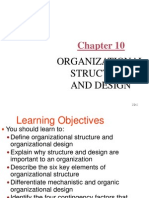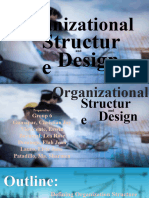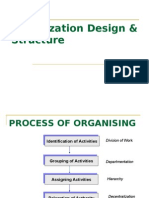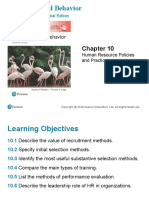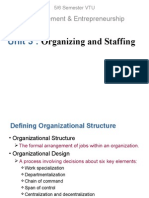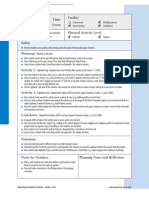Organizational Structure and Design
Organizational Structure and Design
Uploaded by
shawak1Copyright:
Available Formats
Organizational Structure and Design
Organizational Structure and Design
Uploaded by
shawak1Copyright
Available Formats
Share this document
Did you find this document useful?
Is this content inappropriate?
Copyright:
Available Formats
Organizational Structure and Design
Organizational Structure and Design
Uploaded by
shawak1Copyright:
Available Formats
Organizational Structure
and Design
Organizational Structure
The formal arrangement of jobs within an organization
Organizational Design
A process involving decisions about six key elements:
Work specialization
Departmentalization
Chain of command
Span of control
Centralization and decentralization
Formalization
Work Specialization
The degree to which tasks in the
organization are divided into separate jobs
with each step completed by a different
person
Functional
Grouping jobs by
functions performed
Product
Grouping jobs by
product line
Geographical
Grouping jobs on the
basis of territory or
geography
Process
Grouping jobs on the
basis of process or the
no. of process carried
on a product
Customer
Grouping jobs by type
of customer and
needs and customer
flow
Plant Manager
Manager,
Manufacturing
Manager,
Human
Resources
Manager,
Accounting
Manager,
Engineering
Manager,
Purchasing
+ Efficiencies from putting together similar specialties
and people with common skills, knowledge, and
orientations
+ Coordination within functional area
+ In-depth specialization
Poor communication across functional areas
Limited view of organizational goals
Vice President
for Sales
Sales Director,
Central Region
Sales Director,
Southern Region
Sales Director,
Western Region
Sales Director,
Eastern Region
+ More effective and efficient handling of specific
regional issues that arise
+ Serve needs of unique geographic markets
better
Duplication of functions
Can feel isolated from other organizational areas
+ Allows specialization in particular products and
services
+ Managers can become experts in their industry
+ Closer to customers
Duplication of functions
Limited view of organizational goals
Source: Bombardier Annual Report.
CEO.
Truck
Division
Car
Division
Bus
division
+ More efficient flow of work activities
Can only be used with certain types of
products
t
Plant
Manager
Spinning
Dyeing
Weaving
Finishing
+ Customers needs and problems can be met by
specialists
Duplication of functions
Limited view of organizational goals
Director
of Sales
Manager,
Wholesale Accounts
Manager,
Retail Accounts
Manager,
Government Accounts
Chain of Command
The continuous line of authority that
extends from upper levels of an organization
to the lowest levels of the organization and
clarifies who reports to whom
Authority
The rights inherent in a managerial position to tell
people what to do and to expect them to do it
Responsibility
The obligation or expectation to perform.
Responsibility brings with it accountability (the need to
report and justify work to managers superiors)
Unity of Command
The concept that a person should have one boss and
should report only to that person
Delegation
The assignment of authority to another person to carry
out specific duties
Span of Control
The number of employees who can be effectively and
efficiently supervised by a manager
Width of span is affected by:
Skills and abilities of the manager and the employees
Characteristics of the work being done
Similarity of tasks
Complexity of tasks
Physical proximity of subordinates
Standardization of tasks
Sophistication of the organizations information system
Strength of the organizations culture
Preferred style of the manager
Assuming Span of 4
Span of 4:
Employees:
Managers (level 16)
= 4096
= 1365
Span of 8:
Employees:
Managers (level 14)
Assuming Span of 8
1
2
3
4
5
6
7
(Highest)
(Lowest)
Members at Each Level
1
4
16
64
256
1024
4096
1
8
64
512
4096
O
r
g
a
n
i
z
a
t
i
o
n
a
l
L
e
v
e
l
= 4096
= 585
Centralization
The degree to which decision making is
concentrated at a single point in the organization
Organizations in which top managers make all the
decisions and lower-level employees simply carry out
those orders
Decentralization
The degree to which lower-level employees provide
input or actually make decisions
Employee Empowerment
Increasing the decision-making discretion of
employees
More Centralization
Environment is stable
Lower-level managers are not as capable or
experienced at making decisions as upper-level
managers
Lower-level managers do not want to have a say in
decisions
Decisions are significant
Organization is facing a crisis or the risk of company
failure
Company is large
More Decentralization
Environment is complex, uncertain
Lower-level managers are capable and experienced at
making decisions
Lower-level managers want a voice in decisions
Decisions are relatively minor
Corporate culture is open to allowing managers to
have a say in what happens
Company is geographically dispersed
Effective implementation of company strategies
depends on managers having involvement and
flexibility to make decisions
Formalization
The degree to which jobs within the organization
are standardized and the extent to which employee
behavior is guided by rules and procedures
Highly formalized jobs offer little discretion over what is to be
done
Low formalization means fewer constraints on how
employees do their work
Mechanistic Organization
A rigid and tightly
controlled structure
High specialization
Rigid
departmentalization
Narrow spans of control
High formalization
Limited information
network (mostly
downward
communication)
Low decision
participation by lower-
level employees
Organic Organization
Highly flexible and
adaptable structure
Non standardized jobs
Fluid team-based
structure
Little direct supervision
Minimal formal rules
Open communication
network
Empowered employees
Mechanistic
High Specialization
Rigid Departmentalization
Clear Chain of Command
Narrow Spans of Control
Centralization
High Formalization
Organic
Cross-Functional Teams
Cross-Hierarchical Teams
Free Flow of Information
Wide Spans of Control
Decentralization
Low Formalization
Organizational Designs
Traditional
-Simple
Structure
-Functional
-Divisional
Contemporary
-Team
-Matrix-Project
-Boundary less
-Learning
Organization
Traditional Designs
Simple Structure
Low departmentalization, wide spans of control, centralized
authority, little formalization
Functional Structure
Departmentalization by function
Operations, finance, human resources, and product research and
development
Divisional Structure
Composed of separate business units or divisions with
limited autonomy under the coordination and control of the
parent corporation
Contemporary Organizational Designs
Team Structures
The entire organization is made up of work groups or
self-managed teams of empowered employees
Matrix Structures
Specialists for different functional departments are
assigned to work on projects led by project managers
Matrix participants have two managers
Project Structures
Employees work continuously on projects, moving on
to another project as each project is completed
Design
Engineering
Manufacturing
Contract
Administration
Purchasing Accounting
Human
Resources (HR)
Design
Group
Alpha
Project
Manufacturing
Group
Contract
Group
Purchasing
Group
Accounting
Group
HR
Group
Design
Group
Beta
Project
Manufacturing
Group
Contract
Group
Purchasing
Group
Accounting
Group
HR
Group
Design
Group
Gamma
Project
Manufacturing
Group
Contract
Group
Purchasing
Group
Accounting
Group
HR
Group
Design
Group
Omega
Project
Manufacturing
Group
Contract
Group
Purchasing
Group
Accounting
Group
HR
Group
Contemporary Organizational Designs
(contd)
Boundary less Organization
A flexible and an unstructured organizational design
that is intended to break down external barriers
between the organization and its customers and
suppliers
Removes internal (horizontal) boundaries
Eliminates external boundaries
Learning Organization
An organization that has developed the capacity to
continuously learn, adapt, and change through the
practice of knowledge management by employees
Characteristics of a learning organization:
An open team-based organization design that empowers
employees
Extensive and open information sharing
Leadership that provides a shared vision of the
organizations future; support; and encouragement
A strong culture of shared values, trust, openness, and a
sense of community
Linking of two or more organizational
members and/or work units so that they
function well together
Two main types of co-ordination are:
Vertical coordination
Horizontal Coordination
Vertical Coordination:
Linking work units (individual, team,
departments) separated by hierarchical level
Horizontal Coordination:
Linking work units (individual, team,
departments) at the same hierarchical level
Coordination by chain of command
Coordination by leadership
Coordination by committees
Staff meetings
Special Coordinators
Self- coordination
Differences in attitudes and working styles,
arising naturally among members of different
departments, that can complicate
coordination of an organization's activities.
The term lawrence and lorsch use in place of
coordination, to designate the degree to
which members of various departments work
together in a unified manner.
You might also like
- WFP Written Test DraftDocument2 pagesWFP Written Test DraftBolou Germain88% (8)
- Fine Motor Skills of Children With Down SyndromeDocument260 pagesFine Motor Skills of Children With Down SyndromeYurita Kamil100% (4)
- Cer Lesson Plan-2Document5 pagesCer Lesson Plan-2api-404101197No ratings yet
- Organizational Structure and Culture. Hofstede S Four DimensionsDocument13 pagesOrganizational Structure and Culture. Hofstede S Four DimensionsDes Arenas80% (5)
- Organizational Structure and DesignDocument56 pagesOrganizational Structure and DesignPaksmiler100% (2)
- Organizational Design. ReportDocument17 pagesOrganizational Design. ReportArchie Veda Relocano-CapistranoNo ratings yet
- COD Module 3 - Organizational DiagnosisDocument52 pagesCOD Module 3 - Organizational DiagnosisashdetorresNo ratings yet
- Research ProposalDocument59 pagesResearch ProposalSiti ZarehanNo ratings yet
- Group 6 PPT PRESENTATIONDocument58 pagesGroup 6 PPT PRESENTATIONElvie Jane Ligasan LauroNo ratings yet
- Organizational Structure and DesignDocument42 pagesOrganizational Structure and DesignSagar TannaNo ratings yet
- Hofstede's Cultural DimensionDocument12 pagesHofstede's Cultural DimensionKevin DoshiNo ratings yet
- Process, Assumptions, Values N Beliefs of ODDocument21 pagesProcess, Assumptions, Values N Beliefs of ODPankaj Azad100% (2)
- Organization Development AND Interventions: Presented By: Ismail - Shaik 1 2 H P 1 E 0 0 4 1 MBA AlietDocument21 pagesOrganization Development AND Interventions: Presented By: Ismail - Shaik 1 2 H P 1 E 0 0 4 1 MBA AlietErica LimNo ratings yet
- Organisation Development Notes Unit-1Document2 pagesOrganisation Development Notes Unit-1Sreedharan Harshini33% (3)
- Analyzing The Organizational Culture of Yolo County Using Two Assessment ModelsDocument114 pagesAnalyzing The Organizational Culture of Yolo County Using Two Assessment ModelsAtiqah34No ratings yet
- Chapter 7: Designing Effective Organizations: By: Girma Tadesse, PH .DDocument28 pagesChapter 7: Designing Effective Organizations: By: Girma Tadesse, PH .DtilahunthmNo ratings yet
- Organization Development ChangeDocument150 pagesOrganization Development ChangeKaloma PeapeNo ratings yet
- Learning Organization & SocializationDocument31 pagesLearning Organization & Socializationyang liu100% (1)
- Definition of Organization Development Organisation Development Is A SystemDocument30 pagesDefinition of Organization Development Organisation Development Is A SystemAhmed Khan100% (1)
- Organizational Structure & Design (Group 8)Document74 pagesOrganizational Structure & Design (Group 8)rinkuNo ratings yet
- Strengthening Organizational Culture Reference MaterialsDocument6 pagesStrengthening Organizational Culture Reference MaterialsNardsdel RiveraNo ratings yet
- Organizational Structure and CultureDocument33 pagesOrganizational Structure and CulturedpsmafiaNo ratings yet
- The Challenge of Organizational Development (Intro)Document37 pagesThe Challenge of Organizational Development (Intro)Kristelle Brooke Dianne Jarabelo100% (3)
- Robbins Culture-3Document7 pagesRobbins Culture-3Sheikh Araf Ahmed RaadNo ratings yet
- A Presentation On: Presented byDocument19 pagesA Presentation On: Presented byGigo JosephNo ratings yet
- Analyzing The Internal Environment of The FirmDocument7 pagesAnalyzing The Internal Environment of The FirmRegine Balaan Anua100% (1)
- Basic Organizational DesignDocument31 pagesBasic Organizational DesignSahar Hayat AwanNo ratings yet
- Job Analysis: Presented by M.BharathiDocument10 pagesJob Analysis: Presented by M.BharathiLorena AgcaoiliNo ratings yet
- Organization StructureDocument21 pagesOrganization Structuresimply_coool100% (3)
- Stages of Development of OrganizationsDocument10 pagesStages of Development of OrganizationsXtin Ynot0% (1)
- PGP! 2013 Ethical Decision MakingDocument18 pagesPGP! 2013 Ethical Decision Makingharipsgvj0% (1)
- Organizational Effectiveness in Organization's DevelopmentDocument54 pagesOrganizational Effectiveness in Organization's DevelopmentMayurRawoolNo ratings yet
- Management Case StudyDocument2 pagesManagement Case Studynancy goel100% (3)
- The Organization Development PractitionerDocument8 pagesThe Organization Development Practitioneryamatoakito100% (2)
- Creating Customer Value and Customer RelationshipDocument26 pagesCreating Customer Value and Customer RelationshipmeghkknaNo ratings yet
- Strategy Evaluation and ControlDocument45 pagesStrategy Evaluation and ControlFally IPUPA94% (33)
- What Is Organorganization Design?Document4 pagesWhat Is Organorganization Design?mbaib2011No ratings yet
- Cultural Change in OrganizationDocument18 pagesCultural Change in OrganizationSainaath JandhhyaalaNo ratings yet
- Concept of Organizational DevelopmentDocument24 pagesConcept of Organizational DevelopmentAli MujahidNo ratings yet
- Data Base Management SystemDocument15 pagesData Base Management SystemHamid BouleghabNo ratings yet
- Strategic in ActionDocument47 pagesStrategic in ActionIzzy CalangianNo ratings yet
- HRM Vs - Personnel Mgt.Document14 pagesHRM Vs - Personnel Mgt.sau1994100% (1)
- Organizational Effectiveness and Indian ValuesDocument29 pagesOrganizational Effectiveness and Indian Valuesanuj bhardwajNo ratings yet
- Organizational CultureDocument25 pagesOrganizational CultureArcee Ardiente Mondragon100% (3)
- Robbinsjudge Ob18 Inppt 10Document35 pagesRobbinsjudge Ob18 Inppt 10EminNo ratings yet
- Organizational BehaviorDocument14 pagesOrganizational BehaviorpfarazNo ratings yet
- Systems Approach To Management: - Presenter: Rebat Kumar DhakalDocument51 pagesSystems Approach To Management: - Presenter: Rebat Kumar DhakalNirvana NircisNo ratings yet
- 1 Organizations and Organization TheoryDocument50 pages1 Organizations and Organization TheorydennisNo ratings yet
- Organizational Structure and DesignDocument89 pagesOrganizational Structure and DesignmahadevavrNo ratings yet
- Types and Classification of Organisational StructuresDocument16 pagesTypes and Classification of Organisational Structurespratiksha gaurNo ratings yet
- Case Studies On Group Behavior and Work PDFDocument27 pagesCase Studies On Group Behavior and Work PDFShriya Chhabra AroraNo ratings yet
- Product and Service Development and InnovationDocument27 pagesProduct and Service Development and InnovationRayan Mukherjee100% (1)
- Organization CultureDocument47 pagesOrganization CultureUsman Talat Butt100% (1)
- ORGANIZATIONAL RESTRUCTURING AND ITS CONSEQUENCES: Rhetorical and StructuralDocument19 pagesORGANIZATIONAL RESTRUCTURING AND ITS CONSEQUENCES: Rhetorical and StructuralSilvio CandidoNo ratings yet
- Module 6 Culture Lecture NotesDocument17 pagesModule 6 Culture Lecture Notes20174shravyarputhranNo ratings yet
- Burke-Litwin Change Model: Approaches To Managing Organizational ChangeDocument11 pagesBurke-Litwin Change Model: Approaches To Managing Organizational Changeankitgautam89No ratings yet
- Organisational ChangeDocument13 pagesOrganisational ChangeAnusha SinghNo ratings yet
- Equity Theory OverviewDocument22 pagesEquity Theory OverviewFahad KhanNo ratings yet
- Transformational Leadership in Organizational TransformationDocument11 pagesTransformational Leadership in Organizational Transformationwong deso100% (1)
- Does Culture Matter in Competence Management?: Transforming Barriers to EnablersFrom EverandDoes Culture Matter in Competence Management?: Transforming Barriers to EnablersNo ratings yet
- Chap - 10 - Organizational Structure and DesignDocument37 pagesChap - 10 - Organizational Structure and DesignMuhammad_Usama92100% (1)
- 5/6 Semester VTUDocument21 pages5/6 Semester VTUmicrocomputerNo ratings yet
- WK7 - Organizational Structure and Design PDFDocument38 pagesWK7 - Organizational Structure and Design PDFAbdullah Zakariyya100% (4)
- Organization Structure and DesignDocument32 pagesOrganization Structure and DesignPratyum PradhanNo ratings yet
- Post ReviewDocument1 pagePost Reviewapi-358330682No ratings yet
- Case Study ScenarioDocument3 pagesCase Study Scenarioapi-317622388No ratings yet
- Reflective Essay and InterviewDocument2 pagesReflective Essay and InterviewCathee ZhengNo ratings yet
- Implementing Strategies - Management & Operations IssuesDocument31 pagesImplementing Strategies - Management & Operations IssuesELMUNTHIR BEN AMMAR100% (1)
- Activity 6 - Kohlberg Vygotsky Bronfenbrenner TheoriesDocument8 pagesActivity 6 - Kohlberg Vygotsky Bronfenbrenner Theorieszde eamNo ratings yet
- Summative AssessmentsDocument16 pagesSummative AssessmentsForbetNo ratings yet
- Dishant Donga - Reflection EssayDocument5 pagesDishant Donga - Reflection Essayapi-262443638No ratings yet
- Introduction To Media and Information LiteracyDocument9 pagesIntroduction To Media and Information LiteracyJulianne BatomalaqueNo ratings yet
- Gangguan SomatoformDocument41 pagesGangguan SomatoformKhaidarni Arni100% (1)
- Demonstrates Writing Skills: Objective 19Document3 pagesDemonstrates Writing Skills: Objective 19eman100% (1)
- Pap - Lesson Plan 6Document3 pagesPap - Lesson Plan 6api-698038829No ratings yet
- Best Test DesignDocument242 pagesBest Test Designjose peralesNo ratings yet
- Dpa 1-3 Alph GamesDocument1 pageDpa 1-3 Alph Gamesapi-277266097No ratings yet
- DntunclsDocument21 pagesDntunclsLilacx ButterflyNo ratings yet
- KHJJHJDocument24 pagesKHJJHJmkhattakfocusedNo ratings yet
- Hunt and BeglarDocument9 pagesHunt and BeglarAlassfar AbdelNo ratings yet
- Managing Information Systems: Seventh Canadian EditionDocument28 pagesManaging Information Systems: Seventh Canadian EditionRyanNo ratings yet
- A Comparison of Two Data Collecting Methods: Interviews and QuestionnairesDocument10 pagesA Comparison of Two Data Collecting Methods: Interviews and QuestionnairesDurre AdanNo ratings yet
- Contrastive Text AnalysisDocument7 pagesContrastive Text AnalysisMozayan Al JarrahNo ratings yet
- Group Project Part 12 Full MidtermDocument7 pagesGroup Project Part 12 Full MidtermVăn Thị Thanh ThủyNo ratings yet
- Practical Viva QuestionsDocument4 pagesPractical Viva Questionsdasha.shripathyNo ratings yet
- Macro Social Work Practice: A Call To ActionDocument5 pagesMacro Social Work Practice: A Call To ActionMary NienowNo ratings yet
- A Comparison of Modern Turkic Languages (Azerbaijan, Kazakh, Kyrgyz, Turkish, Uzbek) in Terms of Most Frequently Used 1000 WordsDocument35 pagesA Comparison of Modern Turkic Languages (Azerbaijan, Kazakh, Kyrgyz, Turkish, Uzbek) in Terms of Most Frequently Used 1000 WordsAfraNo ratings yet
- 2012 Narrative Criticism A Systematic Approach To The Analysis of StoryDocument9 pages2012 Narrative Criticism A Systematic Approach To The Analysis of StorySamuel Andrés AriasNo ratings yet
- Artificial IntelligenceDocument39 pagesArtificial IntelligenceAlan Jay ManzanoNo ratings yet
- Meta EthicsDocument11 pagesMeta EthicsAlessandraChuaNo ratings yet




